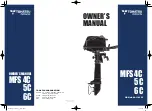
2-1
1. THE IMPORTANCE OF PROPER SERVICING
Proper servicing is essential to the safety of the operator and
the reliability of the outboard motor. Any error or oversight
made by the technician while servicing can easily result in
faulty operation, damage to the outboard motor or injury to the
operator.
Some of the most important precautions are given below.
However, we cannot warn you of every conceivable hazard that
can arise in performing maintenance or repairs. Only you can
decide whether or not you should perform a given task.
2. IMPORTANT SAFETY PRECAUTIONS
Make sure you have a clear understanding of all basic shop safety practices and that you are wearing appropriate
clothing and using safety equipment. When performing any service task, be especially careful of the following:
• Read all of the instructions before you begin, and make sure you have the tools, the replacement or repair parts, and
the skills required to perform the tasks safely and completely.
• Protect your eyes by using proper safety glasses, goggles, or face shields any time you hammer, drill, grind, or work
around pressurized air or liquids, and springs or other stored-energy components. If there is any doubt, put on eye
protection.
• Use other protective wear when necessary, for example, gloves or safety shoes. Handling hot or sharp parts can cause
severe burns or cuts. Before you grab something that looks like it can hurt you, stop and put on gloves.
• Protect yourself and others whenever you have engine-powered equipment up in the air.
Any time you lift an outboard motor with a hoist, make sure that the hoist hook is securely attached to the outboard
motor.
Make sure the engine is off before you begin any servicing procedures, unless the instruction tells you to do otherwise.
This will help eliminate several potential hazards:
• Carbon monoxide poisoning from engine exhaust. Be sure there is adequate ventilation whenever you run the engine.
• Burns from hot parts. Let the engine and exhaust system cool before working in those areas.
• Injury from moving parts. If the instruction tells you to run the engine, be sure your hands, fingers, and clothing are
out of the way.
Gasoline vapors and hydrogen gasses from batteries are explosive. To reduce the possibility of a fire or explosion, be
careful when working around gasoline or batteries.
• Use only a nonflammable solvent, not gasoline, to clean parts.
• Never drain or store gasoline in an open container.
• Keep all cigarettes, sparks, and flames away from the battery and all fuel-related parts.
1. THE IMPORTANCE OF PROPER SERVICING
2. IMPORTANT SAFETY PRECAUTIONS
3. SERVICE RULES
4. SYMBOLS USED IN THIS MANUAL
5. SERIAL NUMBER LOCATIONS
6. MAINTENANCE STANDARDS
7. TORQUE VALUES
8. SPECIAL TOOLS
9. TROUBLESHOOTING
10. CABLE/HARNESS ROUTING
11. TUBE ROUTING
12. LUBRICATION
2. SERVICE INFORMATION
WARNING
Improper servicing can cause an unsafe condition
that can lead to serious injury or death.
Follow the procedures and precautions in this
shop manual carefully.
WARNING
Failure to properly follow maintenance
instructions and precautions can cause you to be
seriously hurt or killed.
Follow the procedures and precautions in this
shop manual carefully.












































